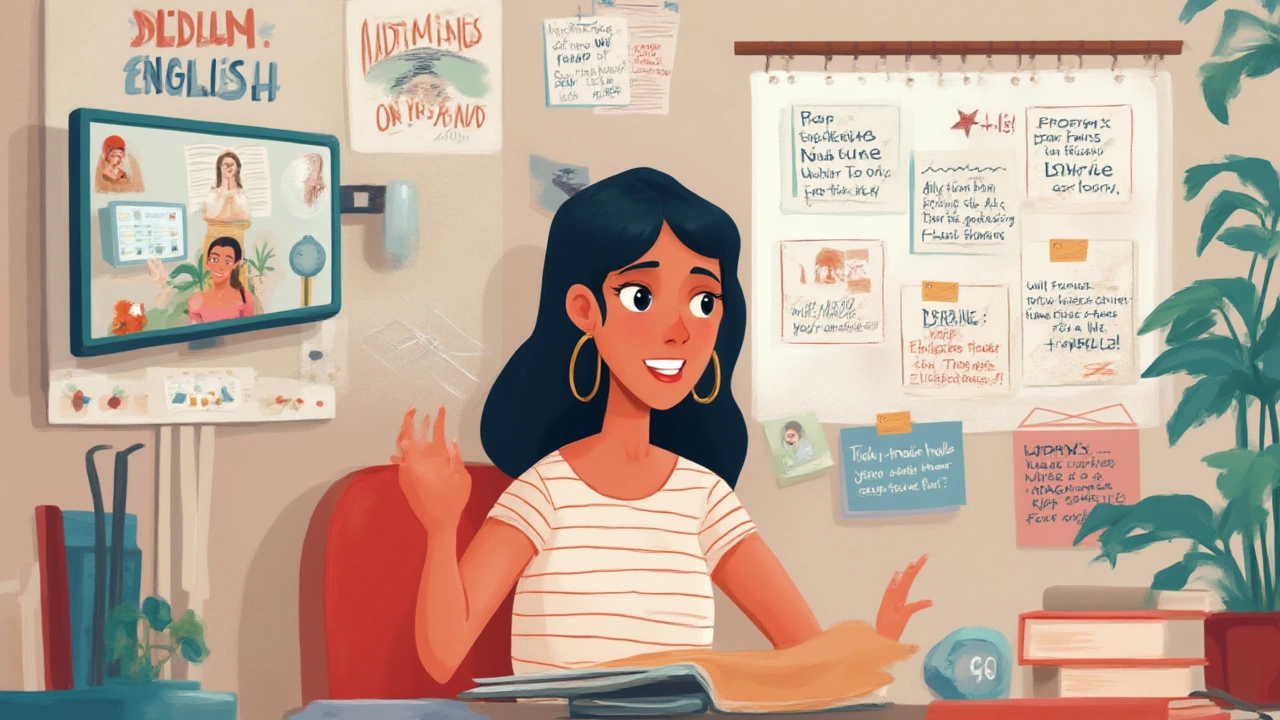Imagine sitting in a cozy café in London or watching a show without subtitles—fluent, confident, completely comfortable. But how long before you get there? C1 in English isn’t just another checkpoint. It’s the bridge to real conversations, university textbooks, and jobs where English isn’t only a tool, but the main event. So, the big question: how many hours does it actually take to reach C1? Spoiler—no, it’s not some random number. Let’s go deep.
What Does 'C1' Mean, Really?
C1 is not just a fancy label. According to the Common European Framework of Reference for Languages (CEFR), it means you can handle most situations without searching for words every second or second guessing yourself. You can argue a point, write a structured essay, understand TV without sweating every word. But C1 is not being native-level. Imagine giving a spontaneous presentation or writing an email at work without thinking twice—that’s C1. Sounds freeing, doesn’t it?
Thousands of learners eye this target because it’s where the magic happens: universities, international jobs, leading online meetings, or even cracking that British humor. Let’s clear up the fog on what it takes:
- You should understand long and demanding texts—even news analysis.
- Express ideas clearly without missing the message.
- Use flexible language styles: formal, casual, funny, or even sarcastic.
- Interact fluently with natives without awkward pauses.
Now, how do you measure whether you've reached this level? International exams like IELTS, Cambridge Advanced (CAE), or TOEFL (around 95-120) set their standards close to C1. But here's a fun twist: even people with certificates sometimes feel uncomfortable in real life! That’s why hours and practice matter more than a shiny diploma.
Quick fact: The CEFR is followed in over 40 countries—universities and workplaces trust it. Cambridge University says “C1 Advanced shows a candidate is a high achiever.” Sounds great, right?
Here’s a myth-buster: you don’t have to read Shakespeare or debate Brexit to hit this mark. Day-to-day language, mixing reading, listening, writing, and speaking, does the job faster than you might think.

How Many Hours Does It Take, Really?
Let’s not beat around the bush—the real number floats between 700 and 1,000 hours for most learners starting from scratch. Yes, you read that right. But don’t let that number haunt you. It’s not a prison sentence.
English schools, app creators, and language teachers usually refer to stats from the Cambridge English Language Assessment and the Foreign Service Institute (FSI). Both point to roughly 600-800 hours to jump from nothing to B2 (upper intermediate), and then another 200-300 hours to reach C1.
| Level | Estimated Hours from Zero | Description |
|---|---|---|
| A1 (Beginner) | 90-100 | Basic phrases, daily needs |
| A2 (Elementary) | 180-200 | Simple conversations, directions |
| B1 (Intermediate) | 350-400 | Travel, basic work topics |
| B2 (Upper Intermediate) | 550-600 | Conversations, TV shows |
| C1 (Advanced) | 700-1,000 | Fluency, complex topics, social confidence |
Sounds like a lot, but here’s the real catch—it’s not linear. Moving from A1 to A2 is much easier (and quicker) than going from B2 to C1. Each new level takes more hours, more attention, and more brain power. From B2 to C1, you need those extra 200-400 hours just to iron out the quirks, idioms, word play, sarcasm, and fluid writing.
It’s also personal. For example, my son Kian picks up new languages faster than my daughter Nitya—maybe it’s because he’s glued to his iPad and chats with online friends from all over. Nitya, on the other hand, loves reading comics, which gives her a knack for quirky phrases but sometimes slows her speaking pace. So yes, motivation, background, talent, daily exposure—these all tilt the ‘hours’ calculator.
Ready to check if you’re close? If you can easily follow a complex podcast or join in on debates at your workplace, you’re brushing past B2 into C1 territory. But if you stumble on slang, humor, or explaining abstract ideas, more hours (especially with speaking and writing) will help.
Note: Many learners don’t count “passive” hours. If you binge a Netflix series in English, that’s learning time! The FSI says both classroom and self-study hours count. So evenings with The Crown, or explaining TikTok trends to Rocky (my dog doesn’t judge my accent), are not a waste.

How to Reach C1 Faster—And Smart
Let’s be honest—sitting in a classroom memorizing grammar isn’t the fun way to climb over the C1 wall. You can speed up the process if you stay active and keep things interesting. You don’t need superpowers, just smarter routines. Here’s what helped me, my kids, and a few of my geeky friends:
- Mix up your practice: Don’t just read textbooks. Watch vlogs with slang, listen to podcasts, play story games, join online chats. The more your brain gets hit from different angles, the easier it is to recall stuff in real life.
- Regularity wins: Even a daily blast of 20-30 minutes helps—better than three hours on Sunday and nothing for two weeks. We’ve put up sticky notes in our kitchen for “word of the day”—Nitya sometimes sneaks in funny ones.
- Get talking ASAP: Real conversations, even with yourself, cement memories way better than writing out exercises. If you can, try language exchanges or apps that connect you to real people.
- Write about daily life: Journaling in English, writing emails or online reviews (think Tripadvisor or Amazon), or even posting on Reddit—it all counts. Kian posts about our dog Rocky’s weird habits—it works.
- Make mistakes: You’ll learn faster if you don’t freeze every time you stumble. English speakers are used to accents and ‘off’ sentences. Just keep moving.
- Shadowing technique: Listen to a native speaker and repeat exactly after them—intonation, pauses, emotion. Even five minutes a day polishes your accent and confidence.
Guess what? A 2023 Cambridge study found that learners with a mix of speaking, listening, and writing every week—over 10-12 months—reached C1 about 20% faster than those who only studied grammar. The more you combine “fun” learning and classic study, the more your brain makes connections that stick.
Don’t forget the lazy “passive” time. Watch English TV, listen to radio, overhear native speakers on YouTube. A 2022 EF Education First survey showed that people who spent 5+ hours a week in “passive” English (TV, music, podcasts) reported higher vocabulary and listening bonuses versus textbook-only students.
For high schoolers or office workers who can’t spend three hours a day, don’t worry. You can break it up—20 minutes reading after breakfast, a podcast on your commute, short written messages to friends in the evening. If you have pets (I know Rocky agrees), even narrating your day out loud in English counts!
Here’s a breakdown of a balanced “C1 week” for quick progress:
| Activity | Hours/Week |
|---|---|
| Classroom/Online lessons | 2 |
| Speaking practice (live or virtual) | 2 |
| Listening (TV/podcasts/radio) | 3 |
| Reading (articles/books/news) | 2 |
| Writing (emails, journaling) | 1 |
| Spontaneous conversations | 1+ |
Add it up: Even with just 9-10 hours a week, you’ll clock over 450 hours in a year. That’s halfway to expert status if you keep the pace. Realistically, if you’re already at B2, you may jump to C1 in 6-12 months with a strong schedule.
Motivation’s key—the closer you are to real-life English (work, travel, friends), the faster your brain soaks it up. Set little milestones (like watching a movie without subtitles, writing a real email, or ordering food abroad), and reward yourself. For some, it’s chocolate, for others, a match with friends, or time with a goofy dog.
One thing I’ve seen with my own kids—learning works best when you can laugh about mistakes, bring friends along, mix up the routine, and use English as a daily tool, not just a subject you’re forced to study.
If you’re aiming for C1, don’t obsess about the exact hour count. Focus on regular exposure, using English for real stuff, and making it fun. As you stack up your hours, you’ll wake up one day, grab a newspaper or join in a heated soccer chat, and realize—you’ve crossed the C1 line.
